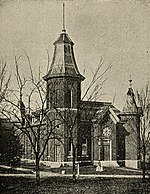Parthenon (Nashville)

The Parthenon in Centennial Park, Nashville, Tennessee, United States, is a full-scale replica of the original Parthenon in Athens, Greece. It was designed by architect William Crawford Smith and built in 1897 as part of the Tennessee Centennial Exposition. Today, the Parthenon, which functions as an art museum, stands as the centerpiece of Centennial Park, a large public park just west of downtown Nashville. Alan LeQuire's 1990 re-creation of the Athena Parthenos statue in the naos (the east room of the main hall) is the focus of the Parthenon just as it was in ancient Greece. Since the building is complete and its decorations were polychromed (painted in colors) as close to the presumed original as possible, this replica of the original Parthenon in Athens serves as a monument to what is considered the pinnacle of classical architecture. The plaster replicas of the Parthenon Marbles found in the Treasury Room (the west room of the main hall) are direct casts of the original sculptures which adorned the pediments of the Athenian Parthenon, dating to 438 BC. The surviving originals are housed in the British Museum in London and at the Acropolis Museum in Athens.
Excerpt from the Wikipedia article Parthenon (Nashville) (License: CC BY-SA 3.0, Authors, Images).Parthenon (Nashville)
Centennial Park Trail - Centennial Loop Connector, Nashville-Davidson
Geographical coordinates (GPS) Address External links Nearby Places Show on map
Geographical coordinates (GPS)
| Latitude | Longitude |
|---|---|
| N 36.149722222222 ° | E -86.813333333333 ° |
Address
Parthenon
Centennial Park Trail - Centennial Loop Connector
37235 Nashville-Davidson
Tennessee, United States
Open on Google Maps









